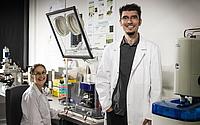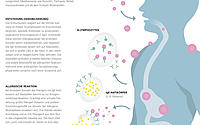- Climate, Environment & Health
- Materials
ALLERGIES ON PLASTIC

Around 20 million Germans reportedly suffer from allergic reactions. At the doctor's office, patients are examined on suspicion with simple but unpleasant tests: For example, an allergen is dripped onto the skin and the skin is lightly pricked. If the skin reddens or wheals appear, this indicates at least a sensitization. Michael Hirtz and his research team at KIT, together with biologists, are developing a technology that not only makes allergy tests more precise and less unpleasant, but also enables better allergy treatment.
„We are developing artificial surfaces on which we can directly observe the activation of immune cells during an allergic reaction. This provides previously unknown insights into the reaction itself," explains Michael Hirtz, who has been developing structured surfaces for special applications using nanolithography at KIT for five years. This caught the attention of EUROIMMUN AG, which specializes in laboratory diagnostics.
"As a leading manufacturer of medical laboratory diagnostics, we rely on modern production processes and microanalysis techniques, some of which are patented worldwide. With our test systems, it is possible to determine a wide variety of antibodies in the serum of patients and thus diagnose autoimmune and infectious diseases as well as allergies. The technology developed at KIT opened up new possibilities for diagnostics and therapy support in allergies," said Alf Weimann, head of the Allergy Diagnostics Department at EUROIMMUN.
So far, Hirtz and his colleagues have been able to show in the laboratory that allergens specifically placed on their artificially created surfaces trigger allergic reactions in mast cells and that it is possible to observe these reactions in detail under a high-resolution microscope. KIT and EUROIMMUN, together with the University Hospital of Lübeck, are now investigating whether it is possible to test real human cells with allergens relevant to everyday life with this method. In the future, blood samples taken from patients could be stored on a small chip in the doctor's office to show whether wasp stings, birch pollen or house dust are the cause of unpleasant symptoms. "This is particularly interesting for desensitization, when you want to observe which treatment has which effect over a longer period of time," says physicist Michael Hirtz.
If the method works, anti-allergic agents such as cortisone could also be scrutinized more closely. Although their efficacy is undisputed, it is not yet fully clear exactly where the drug's rapid action begins in the allergy reaction cascade. Knowledge that is more accurate could be used to develop more effective anti-allergic drugs with fewer side effects.
Hirtz's research focuses on the use of so-called dip-pen nanolithography, which creates bioactive surface structures using an atomic force microscope. Like a nanometer-sized quill pen, the microscope writes "molecular ink" on surfaces, creating arbitrary patterns at scales smaller than cells. In addition to medical diagnostics and biomedical research, the technology can also be used in sensors to apply targeted, high-resolution functional materials. This enables sensitive detection of a wide variety of target molecules.
„Since I was a kid, I have been drawn to becoming a scientist, exploring the unknown and realizing things that no one else has done."
Images: KIT




